CHAPTER 5 SOURCES
Erie Canal Village, www.eriecanalvillage.net
Fort Rickey Children’s Discovery Zoo, www.fortrickey.com
History Masonic Care Community of New York, www.masonichomeny.org/about-us/history History of the Village of Oriskany, http://villageoforiskany.org/content/history, 2013 Village of Oriskany, Oneida County, New York.
Oriskany Battlefield State Historic Site, New York State Office of Parks, Recreation, & Historic Preservation, http://nysparks.com/historic-sites/21/details.aspx
Sylvan Beach Amusement Park, www.sylvanbeachamusementpark.com
Town of Trenton, http://town.trenton.ny.us
Tracey, Sara, “A trek back in time,” Observer-Dispatch, Saturday, May 10, 2014
Utica Parks and Parkway System Timeline, Central New York Conservancy, www.cnyconservancy.org/history-archives/timeline
Utica Zoo Newz, Centennial Edition. Utica, New York, 2014.
❖
Catholic schools flourished in Utica
during the 20th century, owing
perhaps to the large influx of Catholic
immigrants to the region’s factories
during the textile era. The Utica
Catholic Academy girl’s choir is seen
here performing in the Savings Bank
of Utica during the 1950s.
8 4 ✦ O N E I D A C O U N T Y : A n I l l u s t r a t e d H i s t o r y XXON Sharing the Heritage_Layout 1 1/23/2015 11:11 AM Page 85
SHARING THE HERITAGE
H i s t o r i c p r o f i l e s o f b u s i n e s s e s , o r g a n i z a t i o n s , a n d f a m i l i e s t h a t h a v e c o n t r i b u t e d t o t h e d e v e l o p m e n t a n d e c o n o m i c b a s e o f O n e i d a C o u n t y
M o h a w k Va l l e y C o m m u n i t y C o l l e g e . . . . . . . . . . . . . . . . . . . . . . . . . . . . . . . . . . . . . . . . . . . . . . . . . . . . 8 6
W i l c o r I n t e r n a t i o n a l , I n c . . . . . . . . . . . . . . . . . . . . . . . . . . . . . . . . . . . . . . . . . . . . . . . . . . . . . . . . . . . . . . . . . 9 0
M a t t B re w i n g C o m p a n y . . . . . . . . . . . . . . . . . . . . . . . . . . . . . . . . . . . . . . . . . . . . . . . . . . . . . . . . . . . . . . . . . . . . 9 4
U t i c a C o l l e g e . . . . . . . . . . . . . . . . . . . . . . . . . . . . . . . . . . . . . . . . . . . . . . . . . . . . . . . . . . . . . . . . . . . . . . . . . . . . . . . . . 9 8
S t u r g e s M a n u f a c t u r i n g C o . , I n c . . . . . . . . . . . . . . . . . . . . . . . . . . . . . . . . . . . . . . . . . . . . . . . . . . . . . . . 1 0 2
P J G re e n , I n c . . . . . . . . . . . . . . . . . . . . . . . . . . . . . . . . . . . . . . . . . . . . . . . . . . . . . . . . . . . . . . . . . . . . . . . . . . . . . . . 1 0 5
H a m i l t o n C o l l e g e . . . . . . . . . . . . . . . . . . . . . . . . . . . . . . . . . . . . . . . . . . . . . . . . . . . . . . . . . . . . . . . . . . . . . . . . . . 1 0 6
D a r m a n M a n u f a c t u r i n g C o m p a n y, I n c . . . . . . . . . . . . . . . . . . . . . . . . . . . . . . . . . . . . . . . . . . . . . . . 1 0 8
C l i n t o n Tr a c t o r & I m p l e m e n t C o m p a n y, I n c . . . . . . . . . . . . . . . . . . . . . . . . . . . . . . . . . . . . . . . 1 1 0
M a r s h a l l P r z y l u k e , I n c . . . . . . . . . . . . . . . . . . . . . . . . . . . . . . . . . . . . . . . . . . . . . . . . . . . . . . . . . . . . . . . . . . 1 1 2
SPECIAL
M u n s o n - W i l l i a m s - P ro c t o r A r t I n s t i t u t e . . . . . . . . . . . . . . . . . . . . . . . . . . . . . . . . . . . . . . . . . . . . . 1 1 4
I n d i u m C o r p o r a t i o n
THANKS TO
U t i c a ’s Te c h n o l o g y C o m p a n y TM . . . . . . . . . . . . . . . . . . . . . . . . . . . . . . . . . . . . . . . . . . . . . . . . . . . 1 1 6
Tu r n b u l l I n s u r a n c e S e r v i c e . . . . . . . . . . . . . . . . . . . . . . . . . . . . . . . . . . . . . . . . . . . . . . . . . . . . . . . . . . . . . 1 1 8
P re s b y t e r i a n H o m e s & S e r v i c e s , I n c . . . . . . . . . . . . . . . . . . . . . . . . . . . . . . . . . . . . . . . . . . . . . . . . . 1 2 0
G e t n i c k L i v i n g s t o n A t k i n s o n & P r i o re , L L P . . . . . . . . . . . . . . . . . . . . . . . . . . . . . . . . . . . . . . . 1 2 2
R o s e m o n t I n n . . . . . . . . . . . . . . . . . . . . . . . . . . . . . . . . . . . . . . . . . . . . . . . . . . . . . . . . . . . . . . . . . . . . . . . . . . . . . . . 1 2 4
New York State
B a r t e l l M a c h i n e r y S y s t e m s , L . L . C .
Tool Company
M e m b e r o f t h e H e i c o C o m p a n i e s , P e t t i b o n e L . L . C . G ro u p . . . . . . . . . . . . . . . 1 2 6
A Tr i b u t e t o M a r t i n J . N u n n . . . . . . . . . . . . . . . . . . . . . . . . . . . . . . . . . . . . . . . . . . . . . . . . . . . . . . . . . . . 1 2 8
C o n M e d C o r p o r a t i o n . . . . . . . . . . . . . . . . . . . . . . . . . . . . . . . . . . . . . . . . . . . . . . . . . . . . . . . . . . . . . . . . . . . . . 1 3 0
D i m b l e b y, F r i e d e l , W i l l i a m s & E d m u n d s F u n e r a l H o m e s . . . . . . . . . . . . . . . . . . . . . . 1 3 2
F o r t S c h u y l e r C l u b . . . . . . . . . . . . . . . . . . . . . . . . . . . . . . . . . . . . . . . . . . . . . . . . . . . . . . . . . . . . . . . . . . . . . . . . 1 3 4
T h e S a v o y R e s t a u r a n t
T h e B e e c h e s I n n a n d C o n f e re n c e C e n t e r . . . . . . . . . . . . . . . . . . . . . . . . . . . . . . . . . . . . . . . 1 3 6
O n e i d a C o u n t y H i s t o r i c a l S o c i e t y . . . . . . . . . . . . . . . . . . . . . . . . . . . . . . . . . . . . . . . . . . . . . . . . . . . . 1 3 8
M o h a w k L t d . . . . . . . . . . . . . . . . . . . . . . . . . . . . . . . . . . . . . . . . . . . . . . . . . . . . . . . . . . . . . . . . . . . . . . . . . . . . . . . . . 1 3 9
O ’ S c u g n i z z o P i z z a . . . . . . . . . . . . . . . . . . . . . . . . . . . . . . . . . . . . . . . . . . . . . . . . . . . . . . . . . . . . . . . . . . . . . . . . . 1 4 0
B a u m ’s C a s t o r i n e C o . , I n c . . . . . . . . . . . . . . . . . . . . . . . . . . . . . . . . . . . . . . . . . . . . . . . . . . . . . . . . . . . . . . 1 4 1
S h a r i n g t h e H e r i t a g e ✦ 8 5


XXON Sharing the Heritage_Layout 1 1/23/2015 11:11 AM Page 86
was located in the Country Day School, and then
MOHAWK VALLEY COMMUNITY COLLEGE located on Genesee Street in New Hartford, near the present headquarters of Utica National
Insurance. MVCC was one of five post-secondary
institutions established on an experimental basis
to provide technical training for New York
residents, especially for returning GI’s.
The Utica Institute specialized initially in
retail business management and had a reported
enrollment of fifty-three students on opening
day, October 14, 1946. More than two-thirds of
the first students were veterans and tuition was
free for New York residents. The school’s first
Director was Paul B. Richardson.
The Institute was organized so quickly that
the Board decided to open it right away. Because
of this, some faculty spent the weekend before
students arrived unpacking and setting up
furniture. In a thirtieth anniversary article in the
Syracuse Herald-American, a first-day student
remembered there was not a lot of furniture on
the first day. Desks had to be moved from class
to class, and when new desks finally arrived,
❖
Established in 1946 to help train and educate
students helped put them in classrooms and
Above: The Utica Institute machine
veterans returning from World War II, Mohawk
stencil numbers on them.
tools lab, c. 1950.
Valley Community College has evolved to
In its early days, MVCC adapted its programs
become New York State’s first community
to fit the needs of area industries, allowing
Below: In 1953 the State University of
college, the largest college between Syracuse
students to have a significant and immediate
Applied Arts & Sciences at
and Albany, and the region’s primary provider of
impact on the area. The emergence of a textile
Utica became Mohawk Valley
college education and non-credit training.
program in 1947 gave students the ability to aid
Technical Institute.
Mohawk Valley Community College was
in solving some quality control problems then
founded as the New York State Institute of
plaguing textile factories in the Northeast.
Applied Arts & Sciences in Utica. The Institute
When textile factories in the region started
shutting down and electrical/metal working
companies began to move in, MVCC changed its
curricula to adapt. MVCC was able to train
civilian and military personnel to perform in a
variety of manufacturing activities from drafting
and design to quality control. The courses also
helped students develop the manual skills
needed in such industries.
A second location was opened in 1948 in the
700 block of State Street in the former Utica Steam
Cotton Mill. This building housed programs in
mechanical, electrical and textile technology.
The Institute became a part of the State
University System in 1950 and the name was
changed to the State University of Applied Arts
& Sciences at Utica. The school continued to
be operated by the State Education Department
during this era.
8 6 ✦ O N E I D A C O U N T Y : A n I l l u s t r a t e d H i s t o r y
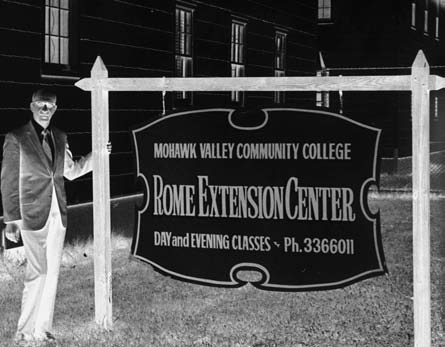
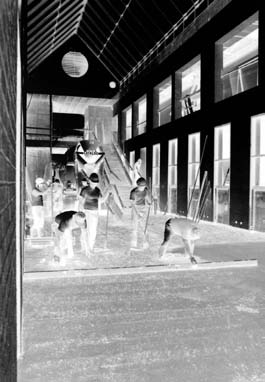
XXON Sharing the Heritage_Layout 1 1/23/2015 11:11 AM Page 87
By the early 1950s, the State Education
Department was seeking a way to bring the
temporary educational experiment to an end. In
1952 the State developed the ‘community
college plan’ under which the institutes could
remain open only if a local sponsor took
responsibility for them and they were converted
to community colleges. Under this plan, the
State no longer provided 100 percent of the
funding, but reduced its operational support to
one-third, with the other two-thirds to come
from the local sponsor and student tuition.
Capital support was reduced to fifty percent with
the local sponsor responsible for the other half.
This created some challenges for the Utica
Institute because a majority of the students
came from other parts of New York. The
problem was solved with a compromise
chargeback system in which other counties
whose students attended one of the community
colleges would pay a chargeback fee to the
At the request of the Air Force, the college
❖
institution. This remains the basis of community
began instruction at Griffiss Air Force Base in
Above: Mohawk Valley Community
college funding in New York State today.
Rome in the early 1950s. Some classes were
College President Dr. Armond Festine
In 1953 the Institute became Mohawk Valley
held on base, others at Staley Junior High
at the MVCC Rome Extension Center
Technical Institute, a community college
School. The present Rome branch campus
in the early 1970s.
sponsored by Oneida County. Albert Payne
opened in 1974 in a portion of the former
was appointed as the Institute’s first chief
Oneida County Hospital on Floyd Avenue. The
Below: Pouring concrete in the atrium
administrator with the title of president.
Plumley Complex was added to the Rome
of the Plumley Complex in 1991.
Over the next decade, the number and
campus in 1991.
variety of instructional programs continued to
grow, including several in non-technical areas
such as liberal arts and sciences. The Institute
was renamed Mohawk Valley Community
College in 1963 to reflect this shift in emphasis.
The main campus on Sherman Drive, which
opened in 1960, was designed by famed architect
Edward Durell Stone, whose world-class projects
included Radio City Music Hall and the Museum
of Modern Art in New York City. The Institute was
Stone’s first design of a college campus and initial
construction included the Academic Building,
Physical Education Building and College Center.
All have been extensively renovated and expanded
over the years. MVCC built its first four
residence halls in 1966—making it the first
New York community college with on-campus
housing—and added a fifth in 2005. Other
buildings have been added, including Payne Hall
in 1969, a science and technology building in
1989, and the Information Technology/Performing
Arts/Conference Center in 2001.
S h a r i n g t h e H e r i t a g e ✦ 8 7
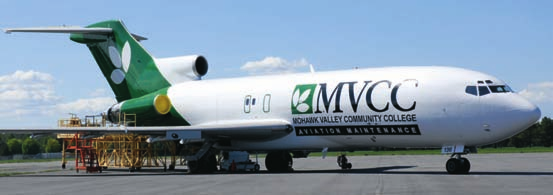
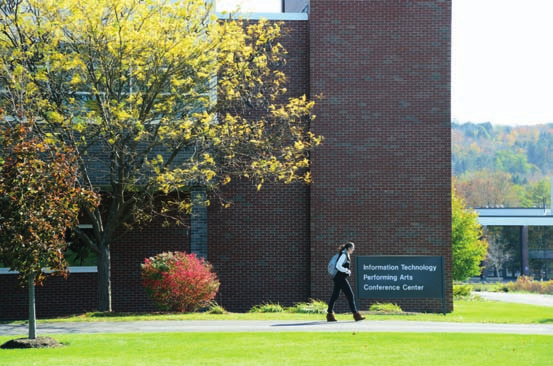
XXON Sharing the Heritage_Layout 1 1/23/2015 11:12 AM Page 88
❖
By 1978, MVCC was generating more than
In 2011 the 112,000-square-foot Robert R.
Above: The Information Technology/
$34 million in business volume annually in
Jorgensen Athletic/Events Center was opened
Performing Arts/Conference Center
Oneida County and providing the equivalent of
on the Utica campus. The facility is named in
opened in 2001.
2,249 full-time jobs.
honor of the school’s long-time athletic director
The school’s more recent growth has been no
and professor emeritus. The complex features
Below: MVCC’s Airframe and Power
less spectacular, with the addition of a number
a 6,000-square-foot fitness center, a field
Plant Technology Program offers
of innovative programs to prepare students for
house with the capacity to host 3,000 people,
students practical, hands-on training
today’s technology.
and many other amenities including three
for aircraft maintenance and repair.
MVCC’s Airframe and Power Plant Technology
basketball/volleyball/tennis courts and an
Program began in 2006 in the Griffiss Business
indoor tenth-of-a-mile track.
and Technology Park in Rome. Students in this
MVCC enrollment grew 25 percent from
program receive practical hands-on training on
2009 to 2012, and 2014 enrollment is 5,277
such aircraft as the Boeing 727-100 freighter,
FTEs (full-time equivalent students). The
which was donated to the program by FedEx.
average age of the students is 25.6 and 76
The three-semester, one-year program emphasizes
percent live in Oneida County. Twenty-one
hands-on experience with maintenance and repair
percent are minority students.
of aircraft engines and structure, leading to a
The school is served by 142 full-time and
Federal Aviation Administration certification.
260 part-time faculty members. The full-time
8 8 ✦ O N E I D A C O U N T Y : A n I l l u s t r a t e d H i s t o r y
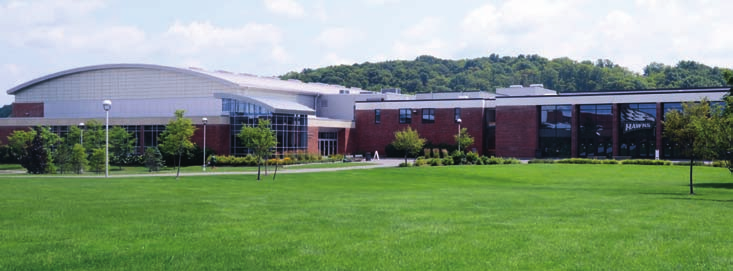
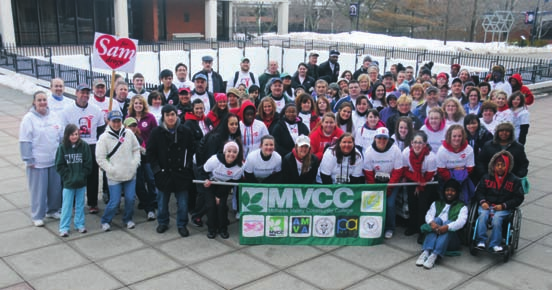
XXON Sharing the Heritage_Layout 1 1/23/2015 11:13 AM Page 89
staff totals 303 with an additional 170 part-
City of Utica and surrounding areas, including
❖
time staff.
the arterial project, the City of Utica Master Plan,
Above: The Robert R. Jorgensen
MVCC’s campuses host more than 150
the launch of the Utica Comets and the
Athletic/Events Center opened
community events annually, ranging from
nanotechnology boom focused around SUNY
in 2011.
committee meetings to the Boilermaker Expo,
Polytechnic Institute and Griffiss Air Base. The
which draws more than 35,000 people to
College’s proud tradition of technical and trade
Below: Each year, MVCC’s faculty,
the Utica campus. Team MVCC promotes
education has positioned it perfectly for the
staff and students participate in a
community activities that provide visibility and
growth in demand for science, technology,
variety of charitable events.
meaningful contribution of participants on
engineering and math degrees. The MVCC
behalf of the College. Each year, faculty, staff
education helps propel students into great careers
and students participate in a variety of events,
in that area. Partnerships with other colleges
including the Alex Kogut Run/Walk, Making
in the state, including Clarkson University,
Strides Against Breast Cancer Walk, United Way
Rensselaer Polytechnic and Utica College are
Campaign, AHA Heart Run/Walk, Veteran’s
becoming even stronger, allowing students to
Center Food Drive, MVCC Foundation Golf
more easily transfer to four-year institutions.
Tournament and many others.
For additional information about Mohawk
Looking to the future, MVCC plans to further
Valley Community College and its programs,
align itself with the progressive changes in the
please visit www.mvcc.edu.
S h a r i n g t h e H e r i t a g e ✦ 8 9
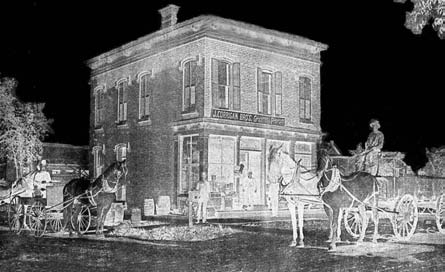
XXON Sharing the Heritage_Layout 1 1/23/2015 11:13 AM Page 90
An ability to evolve in an ever-changing
made products hard to purchase. Determined
WILCOR
market has allowed Wilcor International, Inc.,
to stay in business, they began to purchase
to become a well-known supplier to the
goods from larger wholesalers although this
INTERNATIONAL,
vacation industry. Wilcor offers the largest
meant a much smaller profit.
INC.
variety of products from one source, supplying a
In early 1941, the oldest son, J. C. Corrigan,
dazzling array of nearly 6,000 products to retail
joined the Marine Corps to fight in World War II.
businesses throughout the nation. As times have
In 1944, shortly before the end of the war, the
changed over the decades, the family business
company—now William J. Corrigan and Sons—
has maintained its commitment to quality and
moved to a larger building, which had been the
old fashioned values. Built on a solid foundation
Old Saint Elizabeth’s Hospital at 720 Columbia
of values, Wilcor International, Inc., has grown
Street. The hospital had been closed due to a
to be the number one supplier to the vacation
fire but the building was renovated and
industry with the largest variety of products
reopened as a commercial building.
from one source.
The Corrigan children were in their teens
when the war ended, and business efforts
continued. However, the Korean War began in
1950 and William L. joined the U.S. Marine
Corps and went off to fight for our country. In
his absence, the business started to fail. In 1953
the war ended and William L. returned home
with hopes of saving the company.
There were many changes in business during
this time, with large department stores coming
in and smaller businesses, and those that
serviced them, were closing down. The pace of
business change was fast and included a new
array of discount stores. William J. and Claris
tried to stay in business through trial and error
but when William J. died in 1966, the business
needed a boost.
The brothers parted at this time, each moving
❖
The Corrigan family had a wide variety of
into different businesses; the older brother
Above: J. Corrigan Bros. Groceries
businesses back home in Ireland where their
moved into the candy business and in 1967,
and Provisions in Utica at the turn of
well-rounded ventures included restaurant,
William L. and Eleanor purchased the business
the twentieth century.
funeral home and grocery store businesses.
from Claris.
In the Utica area, Joseph Neil Corrigan ran
The next few years brought many changes
J. Corrigan Bros. Groceries and Provisions on
including small additions of products and
Arthur Street in Utica in 1887. Joseph was
changes in service. William L. had married
William J. Corrigan’s father. In 1921, William J.
Eleanor in 1954, and at this time they had six
and his wife, Claris, began their own
children and were determined to find a way to
distribution business at 1921 Arthur Street,
make the business work.
distributing meat paper, bags, napkins, bath
William L. was the president, a salesperson
tissue, shoe polish, light bulbs, and office and
and a community entertainer who shared his
school supplies to area businesses. World War I
talents with such organizations as the 40/8,
had been over for a few years and the market
the Lions Club, the Association for the Blind,
for distribution of these items had grown.
the Rome and Utica centers for those with
In 1939, William J. and Claris bought the
developmental disorders, and local parades and
Dunmore Estate on Scott Street and moved the
church activities. Eleanor was a stay-at-home
business into a two-story barn near the house.
mom during this period, taking care of all the
The business seemed to be growing before
household responsibilities and child rearing and
World War II began but war-time shortages
becoming a strong participant in her church.
9 0 ✦ O N E I D A C O U N T Y : A n I l l u s t r a t e d H i s t o r y
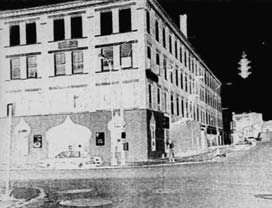
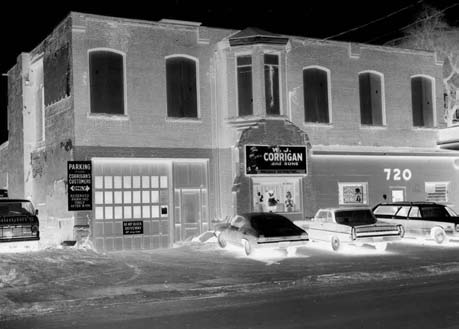
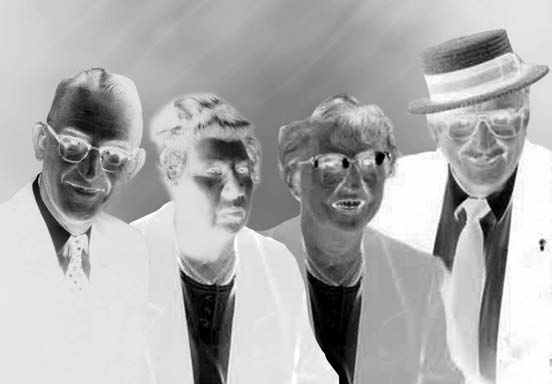
XXON Sharing the Herita















